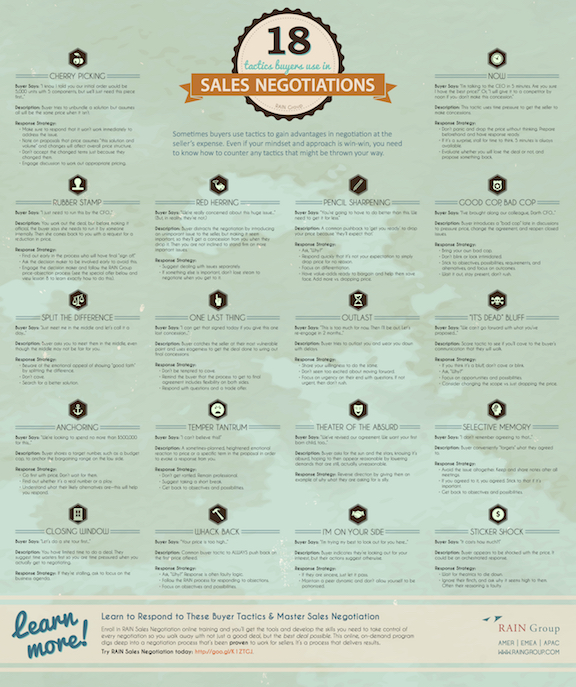How To Overcome These 5 Common Customer Objections

Are your prospects avoiding you?
Is your business not getting the results it needs from your pitches to potential customers?
The problem may be in your approach, which can turn away a valuable lead. An offer that is too detailed or complicated, or priced too high, may be repel a potential customer instead of attracting them. The key to drawing them in is to approach your prospects on their level in a simple way that appeals to their direct needs. Once they know the value in working with your business, then the response will be more favorable.
In an article on Hubspot, 18 objections to sales tactics were presented in this infographic by the RAIN Group, which shows several tactics that can be used when a buyer is resistant:
You can minimize these objections by reducing the amount of time a prospect has to take to listen to or read your pitch, and by getting to the most important points right out of the gate. This “buyer-centric” approach needs to be brief and respectful to your leads. Save your detailed product or service opportunities for later — after they have had a chance to get to know you first.
In today’s fast-paced and competitive world, it’s more important than ever to be fully prepared for answering questions and countering excuses. Here are the 5 most common customer objections, and how your business can successfully negotiate your way to a sale, along with helpful quotes from Inc:
Ask before they exit
When approaching a new lead for the first time, they may not see the value in doing business with you. This can cause them to turn away even before you have a chance to tell them about your offer. Begin the process by asking them in 30 seconds if they would be interested in finding out whether what you have to offer can help them. An example of this might be, “May I take 30 seconds of your time to explain how our product/service can help you and whether you would like for me/us to follow up?”
“The best way to sell yourself to others is first to sell the others to yourself.”
–Napoleon Hill
Show them what makes you different from the competition
Many times, your leads are already working with a company that provides the same product or services that you do. They may be more inclined to stay where they are at, and your job is to help them see how your offering could be even better for them. While referencing their current source, provide them with case studies and attractive price structures that they would want to consider. By maintaining a respectful attitude, your approach should be to provide them with a new alternative they haven’t considered before.
“Ninety percent of selling is conviction and 10 percent is persuasion.”
–Shiv Khera
Get an answer now
One of the biggest exit strategies for a potential customer is to “think about it,” and get back to you later. Acknowledge their time and busy schedule, but give both of you the opportunity to discuss it later with a short meeting and put this on your calendars. Even if they are not ready to do an overview with you at that moment, you can at least confirm a set date that places your business on their agenda.
“To build a long-term, successful enterprise, when you don’t close a sale, open a relationship.”
–Patricia Fripp
Not enough funds
A lack of resources may cause hesitation and doubt in the consumer’s mind. But don’t allow this to stop you from offering helpful alternatives that can draw them into a sale later. Ask a few questions to understand where they are at financially, and provide something of value to them that they can use now such as a free eBook, video, report, etc. This not only establishes trust, but opens the door for a sale later.
“Treat objections as requests for further information.”
–Brian Tracy
Discussions with the “higher ups”
A potential lead may be a manager or assistant to a larger organization, which may cause them to put your pitch on hold while they clear your offer with their superior(s). But this can be an opportunity to meet with higher level executives who make the sales decisions for the company. Keep the doors open by arranging a group meeting while identifying the main needs and issues of their organization.
“All things being equal, people will do business with, and refer business to, those people they know, like, and trust.”
–Bob Burg
When facing rejection or obstacles, use these experiences as a way to learn more about your target market and to develop creative approaches that respects their time and build trust with your company. Even if you get a “no” in the beginning, you can still leave a positive impression for the future.
Susan Gilbert
Latest posts by Susan Gilbert (see all)
- 12 SEO, Digital Marketing Automation, and Live Chat and Chatbot Tools - January 24, 2023
- 12 Time-Saving Blogging, Newsletter Creation, and SaaS Tools - November 29, 2022
- 12 Customer Communication, Instagram Brand Reach, and AI Marketing Plan Tools - October 25, 2022


